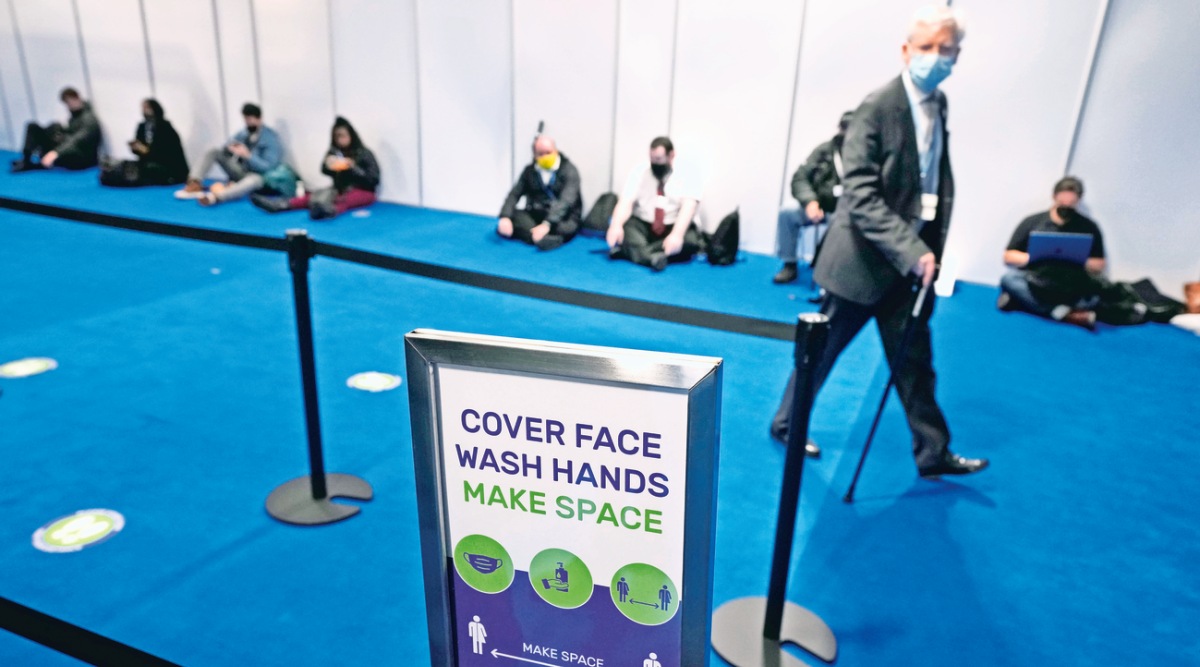 Daily testing, must-vaccine, online meetings, one-hour waits, washroom lines — Glasgow works overtime. (AP/file)
Daily testing, must-vaccine, online meetings, one-hour waits, washroom lines — Glasgow works overtime. (AP/file) The state of the imperilled planet is the pressing concern for everyone here and nothing brings that into sharper focus than the pandemic.
As of this week, half of the world’s population may have got at least a single shot of the vaccine but that’s of little comfort here. Mandatory vaccination, daily testing, limited and spread-out seating arrangements, frequent sanitisation, regular appeals to participants to attend events online if they can — Glasgow is masked and shielded as it hosts the climate change conference.
It’s easier said than done.
Huge crowds back up at the main entrance of the venue every morning; several areas in the conference centre are cramped, including lobbies and halls where the country pavilions are. Social or physical distancing is a challenge.
Part of the reason, ironically, is the surprisingly big interest in this COP-26 (short for Conference of Parties, as the climate change conferences are called).
The most well-attended COPs have been the ones expected to deliver an international agreement — Kyoto in 1997, Copenhagen in 2009 and Paris in 2015. Glasgow was supposed to be a regular COP and still it received the largest number of registrations for participation, close to 40,000, more than Paris’s 36,000 registrations – making it the largest conference in the UK so far.
Sure, not all registered participants turn up. But the actual headcount in Glasgow is expected to touch 30,000. That would still make it the best attended COP ever, Paris clocked 28,000.
Sure, not all participants attend the entire two-week event. They come and go, depending on their work and interest. But any given time at any conference venue, there are at least between 10,000 and 15,000 attendees.
The Glasgow organisers’ Covid protocol list is detailed: only fully-vaccinated people were allowed to come to the COP. In countries where vaccinations are not in good supply, vaccine doses were shipped from the host country to ensure that the COP-bound were vaccinated.
Each participant has been asked to conduct a Covid-19 test every day before coming to the venue. Entry is allowed only after proof of a negative result is shown.
Participants have been given do-it-yourself home testing kits which give results within 15 minutes. These have to be uploaded to a website run by the National Health Service, UK’s public healthcare system. An email sent from NHS in response acts as the entry pass.
For those who land at the venue without taking a test, there are provisions to conduct the test on the spot.
Inside, there are restrictions on how many can be in a meeting room. The largest room can seat less than 150 people at a time. Technically, that means not all countries can participate in any meeting. That’s not much of a problem considering that not every country has to be represented at every meeting.
Countries are part of formal negotiating groups which have common positions on specific issues – so representation from the groups is often adequate.
But observer organisations, including NGOs and inter-governmental organisations, find themselves squeezed out, two categories traditionally very visible and active at a COP. Many of them have complained and the UN Climate Secretariat Friday apologised for the Covid inconvenience. Twice, it had to appeal to participants to attend the meetings online because the rooms were full.
But not everything has been smooth.
Security checks have been slow leading to crowds swelling at the entrance. In fact, the first four days, the average wait to get in was over an hour long. Queues were common outside washrooms because these were being disinfected after every use.
Organising a COP is an extraordinary logistical feat even in ordinary times. Invariably, Prime Ministers or Presidents drop in — more than 100 heads of states or governments have come to Glasgow. Local media has reported about 400 private or chartered planes landing here carrying national leaders, global celebrities and corporate heads.
Traffic has to be diverted, special transport arrangements made, and spaces allocated for the almost-daily protests and demonstrations. No wonder, few cities rush in to host it.
The guard is lowered when the hair is let down – mainly at the protests. The biggest demonstration at this COP was Friday where about 50,000 people marched through the city for several hours. There are no mandated Covid protocols for these protests and unlike the conference, one need not show proof of a negative test to join these protest marches. Only, a commitment to a cause, which the COP is all about anyways.
- The Indian Express website has been rated GREEN for its credibility and trustworthiness by Newsguard, a global service that rates news sources for their journalistic standards.

